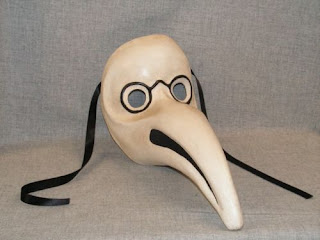The plague doctor - Il Medico della Peste
The Costume - The Mask

(from Wikipedia, the free encyclopedia)
The plague doctor's costume was the clothing worn by a plague doctor to protect him from airborne diseases. The costume, originating in the 17th century, consisted of an ankle length overcoat and a bird-like beak mask often filled with sweet or strong smelling substances (commonly lavender), along with gloves, boots, a brim hat, and an outer over-clothing garment.
The mask had glass openings for the eyes and a curved beak shaped like that of a bird. Straps held the beak in front of the doctor's nose. The mask had two small nose holes and was a type of respirator which contained aromatic items. The beak could hold dried flowers (including roses and carnations), herbs (including mint), spices, camphor, or a vinegar sponge.
The purpose of the mask was to keep away bad smells, which were thought to be the principal cause of the disease in the miasma theory of infection, before it was disproved by germ theory.Doctors believed the herbs would counter the "evil" smells of the plague and prevent them from becoming infected.
The beak doctor costume worn by plague doctors had a wide-brimmed leather hat to indicate their profession. They used wooden canes to point out areas needing attention and to examine patients without touching them. The canes were also used to keep people away, to remove clothing from plague victims without having to touch them, and to take a patient's pulse.

Medical historians have attributed the invention of the "beak doctor" costume to Charles de Lorme, who adopted in 1619 the idea of a full head-to-toe protective garment, modeled after a soldier's armour. This consisted of a bird-like mask with spectacles, and a long leather (Moroccan or Levantine) or waxed-canvas gown which was from the neck to the ankle. The over-clothing garment, as well as leggings, gloves, boots, and a hat, were made of waxed leather. The garment was impregnated with similar fragrant items as the beak mask. The costume may have older roots as some authors have described fourteenth-century plague doctors as wearing bird-like masks.
Lorme wrote that the mask had a "nose half a foot long, shaped like a beak, filled with perfume with only two holes, one on each side near the nostrils, but that can suffice to breathe and to carry along with the air one breathes the impression of the drugs enclosed further along in the beak".
The Genevese physician Jean-Jacques Manget, in his 1721 work Treatise on the Plague written just after the Great Plague of Marseille, describes the costume worn by plague doctors at Nijmegen in 1636-1637. The costume forms the frontispiece of Manget's 1721 work. The plague doctors of Nijmegen also wore beaked masks. Their robes, leggings, hats, and gloves were made of morocco leather.
This costume was also worn by plague doctors during the Plague of 1656, which killed 145,000 people in Rome and 300,000 in Naples. The costume terrified people because it was a sign of imminent death. Plague doctors wore these protective costumes in accordance with their agreements when they attended their plague patients.
The costume is also associated with a commedia dell'arte character called Il Medico della Peste (the Plague Doctor), who wears a distinctive plague doctor's mask. The Venetian mask was normally white, consisting of a hollow beak and round eye-holes covered with clear glass, and is one of the distinctive masks worn during the Carnival of Venice.
from Wikipedia, the free encyclopedia




























































